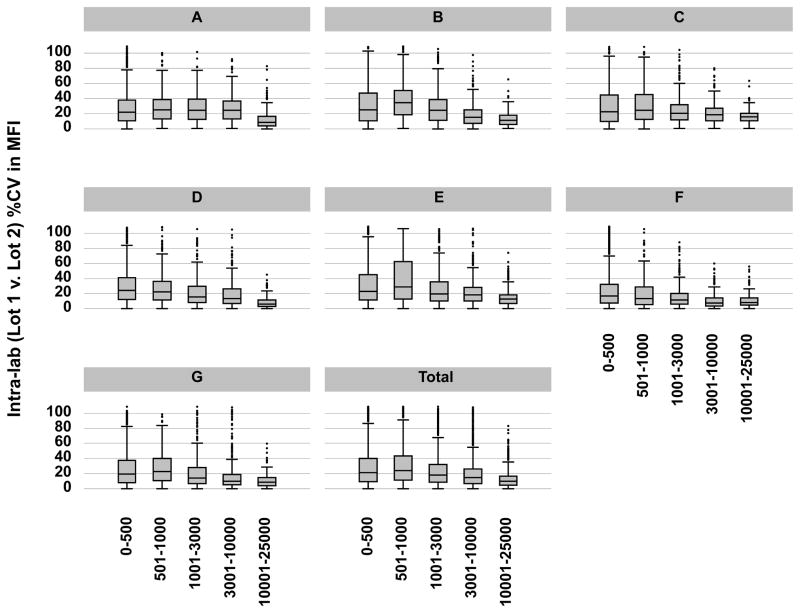To the Editor
We appreciate the opportunity to respond to the letter by Dr. Maillard and Dr. Mariat (1). They raise three questions regarding our recent article focusing on inter-laboratory standardization of solid phase multiplex-bead arrays to detect antibodies to HLA within the framework of the Clinical Trials in Organ Transplantation (2). Our article provides insights into the key sources of variability in commercially available solid phase HLA antibody testing kits. Importantly, our study demonstrates that standardization of reagents and protocols significantly reduces assay variance. Utilization of a global normalization algorithm further reduced MFI variations in the protocol, thereby improving comparison of data across laboratories.
Dr. Maillard and Dr. Mariat comment that our study did not address the prozone effect. Although they raise an important point, we do not believe the prozone effect impacted our estimates of inter-laboratory variance since all participants adopted a standardized protocol, used the same reagents and tested a constant volume of alloantisera. We do agree with Drs. Maillard and Mariat that adding DTT, running dilutions, or employing other methods to explore potential prozone/interfering factors are worthy of systematic investigation.
Drs. Maillard and Mariat correctly point out that the % CV decreases within higher MFI strata. Although they indicate this finding is presented in the Bland-Altman plots ( Ref 2, Figure 5), it is actually illustrated in Figure 3 of our article which shows the variation among seven centers across distinct MFI strata. Drs. Maillard and Mariat suggest that the sudden amelioration in %CV within higher MFI strata is due to saturation of the beads with antibodies. However, as we clearly showed the decline in %CV begins at 1000 MFI, well below a saturation dosage (<10,000 MFI), which indicates saturation is not the primary reason to explain this result
Their third point questions the impact of intra-laboratory variability on results and whether the improvement in %CV was due to a reduction in variance within an individual laboratory or between laboratories. Since it is standard of care that clinical laboratories utilize a standardized SOP for HLA antibody testing, we expect the major cause of assay variance is lot-to-lot differences in test kits. Although we did not specifically address intra-laboratory variability in our report, each data point shown in the Bland-Altman plot (Ref 2, Figure 5) can be converted into a pseudo ‘intra-laboratory’ %CV [i.e., ] representing the variation when a lab repeats the test of same sample and bead across two lots of SA kits. The median intra-laboratory %CV was 19%, and boxplots demonstrate a decline with increasing MFI range within each center and overall (Figure 1). On average, the intra-laboratory %CV was less than our reported inter-laboratory %CV (~25%).
Figure 1. Intra-laboratory lot-to-lot effects on assay variability.
Boxplots of intra-lab %CV in MFI distributions within five strata (0–500, 501–1000, 1001–3000, 3001–10000, 10001–25000) grouped by center (A–G).
Nonetheless, we acknowledge that other sources of variation in the aspects of the assay can certainly contribute to intra-laboratory variability and that each laboratory needs to address these concerns. We anticipate that both inter- and intra-laboratory variance will decrease with the implementation of standardized testing protocols and the increasing availability of uniform lots of reagents.
Acknowledgments
This research was performed as part of an American Recovery and Reinvestment (ARRA) funded project under Award Number U0163594 (to P Heeger), from the National Institute of Allergy and Infectious Diseases. The work was carried out by members of the Clinical Trials in Organ Transplantation (CTOT) and Clinical Trials in Organ Transplantation in Children (CTOT-C) consortia. The content is solely the responsibility of the authors and does not necessarily represent the official views of the National Institute of Allergy and Infectious Diseases or the National Institutes of Health.
This is a commentary on article Maillard N, Mariat C.Solid-phase bead-based assays limitations are not restricted to interlaboratory variability. Retina. 2013;13(11):3049.
Footnotes
Disclosure
The authors of this manuscript have no conflicts of interest to disclose as described by the American Journal of Transplantation.
References
- 1.Maillard N, Mariat C. Solid Phase Bead Based assays limitations are not restricted to inter-laboratory variability. IN PRESS - THIS ISSUE. [DOI] [PubMed] [Google Scholar]
- 2.Reed EF, Rao P, Zhang Z, Gebel H, Bray RA, Guleria I, et al. Comprehensive Assessment and Standardization of Solid Phase Multiplex-Bead Arrays for the Detection of Antibodies to HLA. Am J Transplant. 13(7):1859–70. doi: 10.1111/ajt.12287. [DOI] [PMC free article] [PubMed] [Google Scholar]



